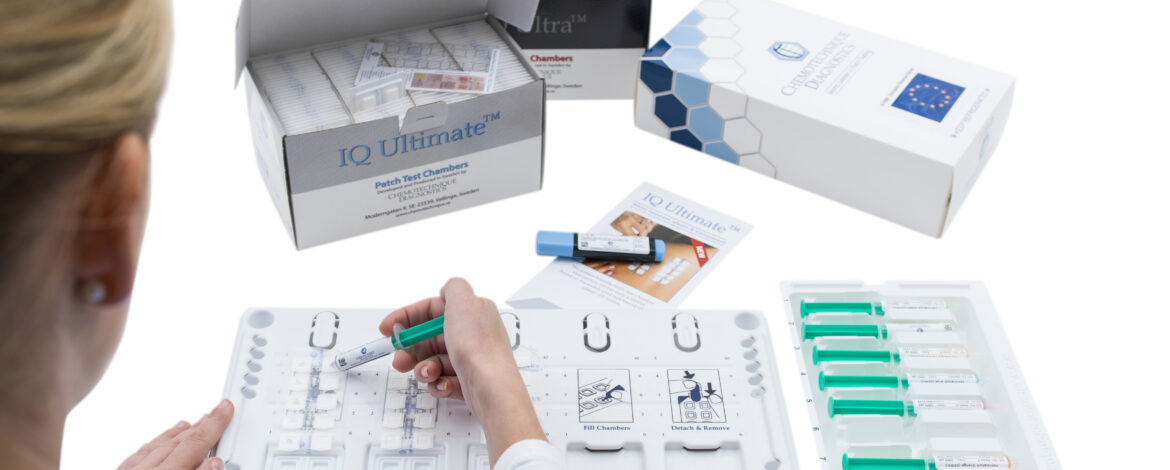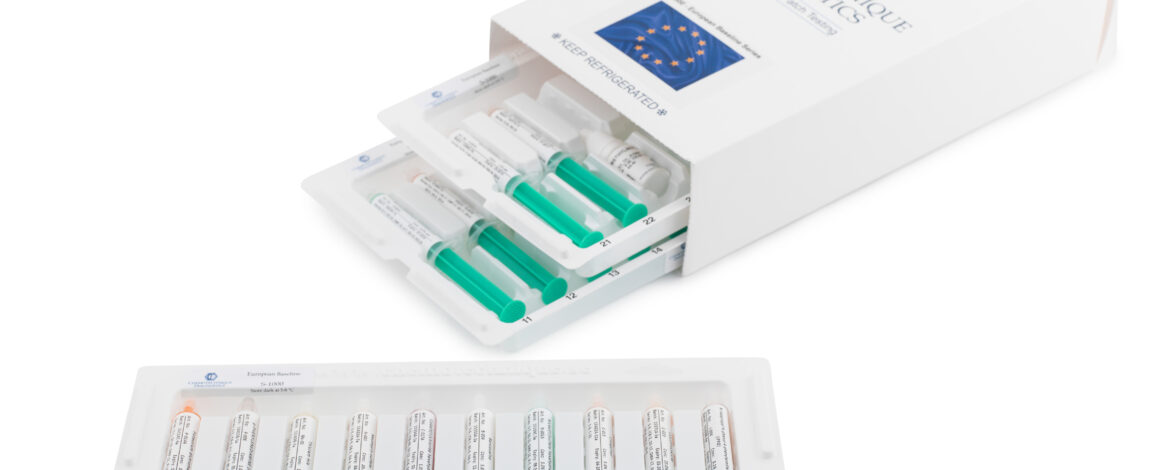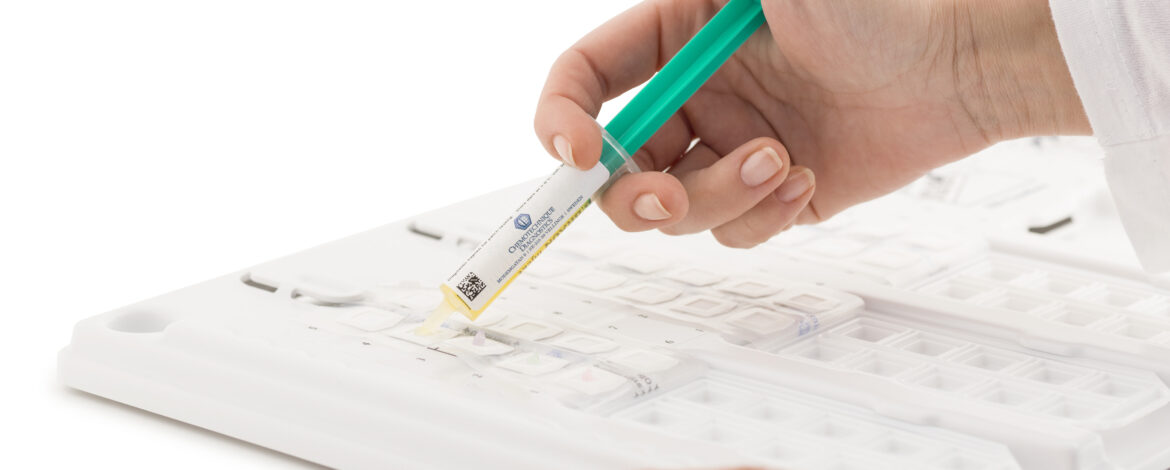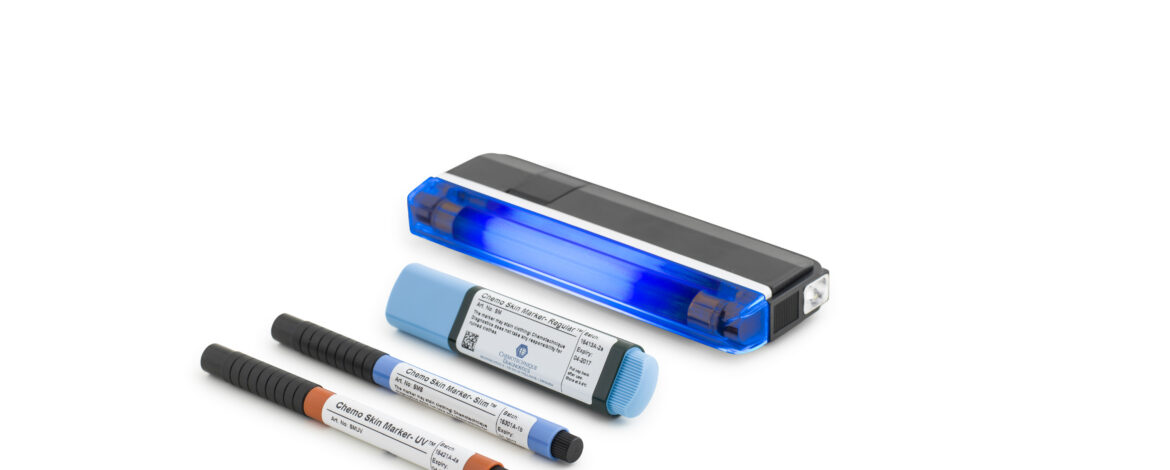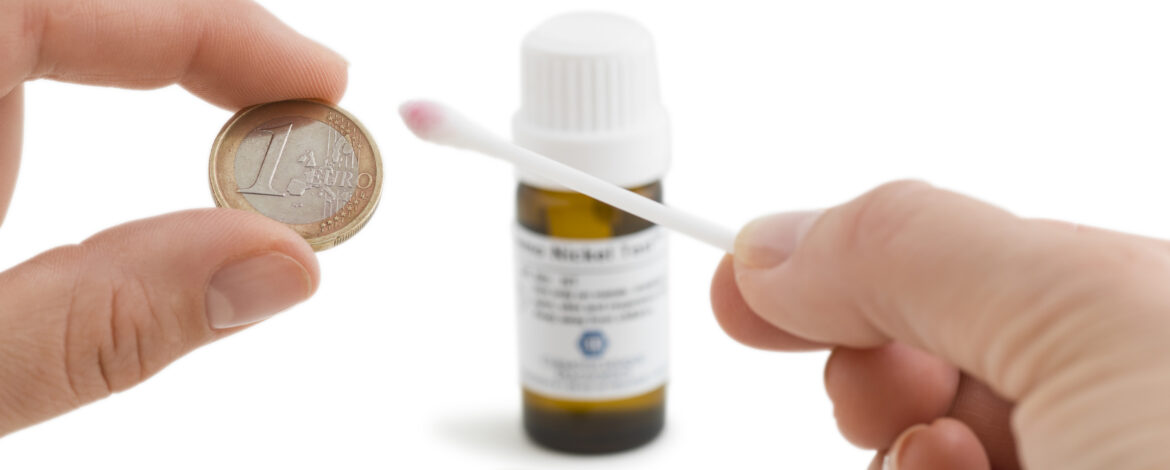Patch Testing
Chemotechnique offers a wide range of high quality Patch Test products to aid the diagnosis of Contact Allergy
Patch testing is a process to detect allergic contact dermatitis to something a person has contacted at home, leisure or at work. It involves applying patches with test substances in small chambers to a person’s back. The patches are secured with hypoallergenic tapes. No needle pricking is involved.
The Chemotechnique Patch Test products are the result of decades of product refinement. The compositions of the Patch Test Hapten Series are determined in close co-operation with national and international Contact Dermatitis groups. Chemotechnique has provided Patch Test solutions since 1981 and is proudly recognized as the Trusted name in Patch Testing.
Comprised of the 60 most common substances known to cause skin allergies in Australia, Chemotechnique Diagnostics Australian Baseline Series 2017 offers superior diagnostic ability and is the recommended series for the general screening of patients with suspected allergic contact dermatitis in Australia. Chemotechnique Diagnostics is the only company to manufacture all 60 of the haptens included within the Australian Baseline Series 2017.
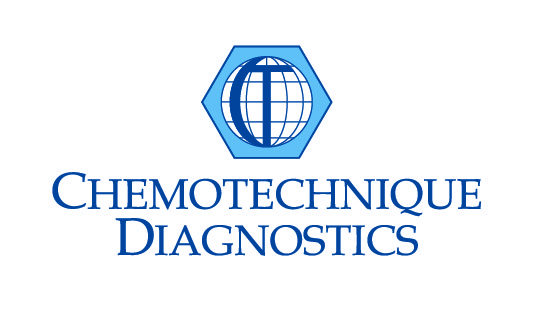
Patch Test Chambers
IQ Ultra™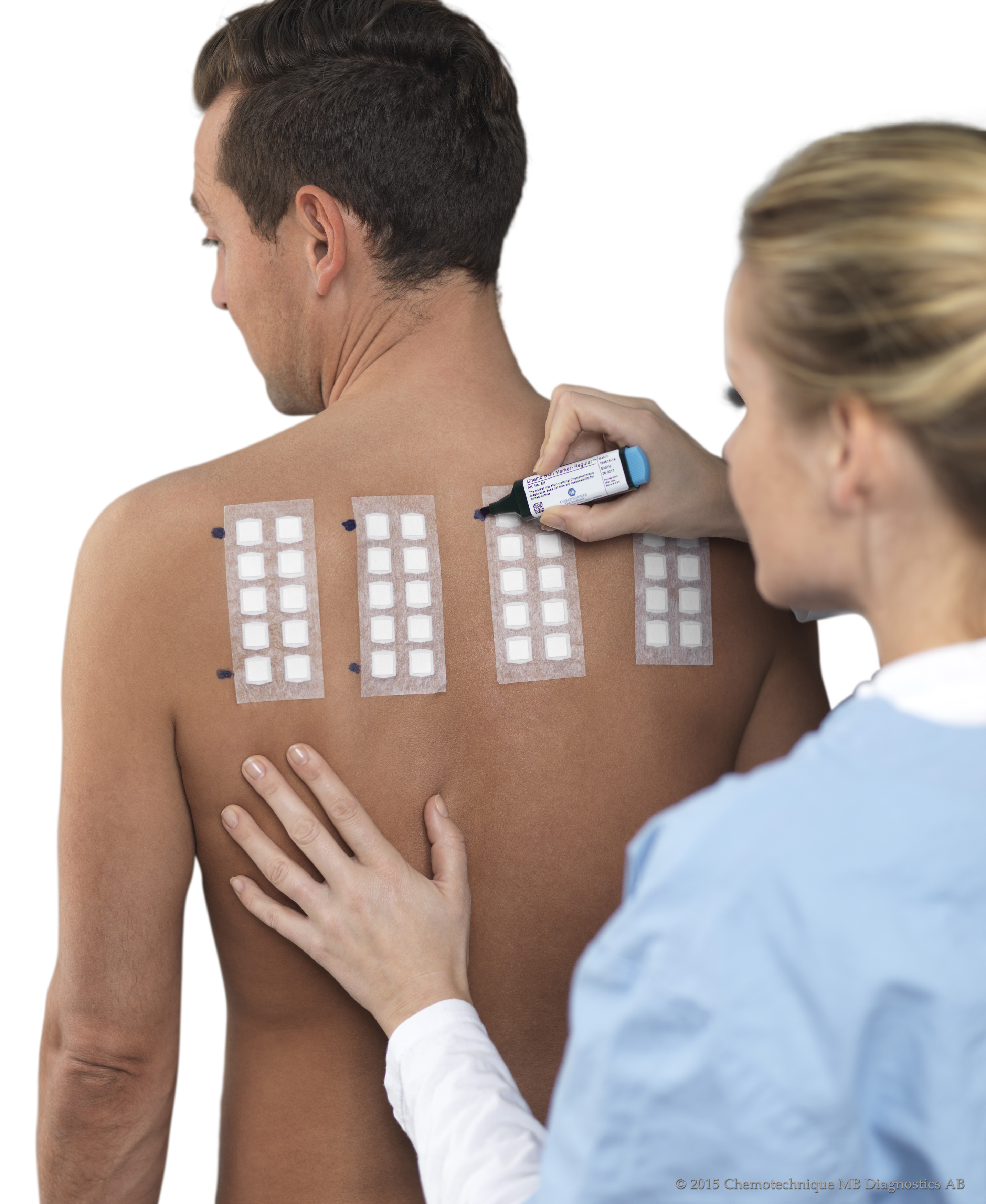
Comfortable and chemically inert - IQ Ultra™ is the reliable patch test choice. The acclaimed IQ chambers are mounted on a premium quality, hypoallergenic and latex free carrier tape. The strong adhesive properties of the unit eliminates the need for reinforcing tape for all cases involving normal skin. The IQ Ultra™ test units are most cost effective; with integrated protective covers and filter papers there is no need to purchase extra items.
IQ Ultimate™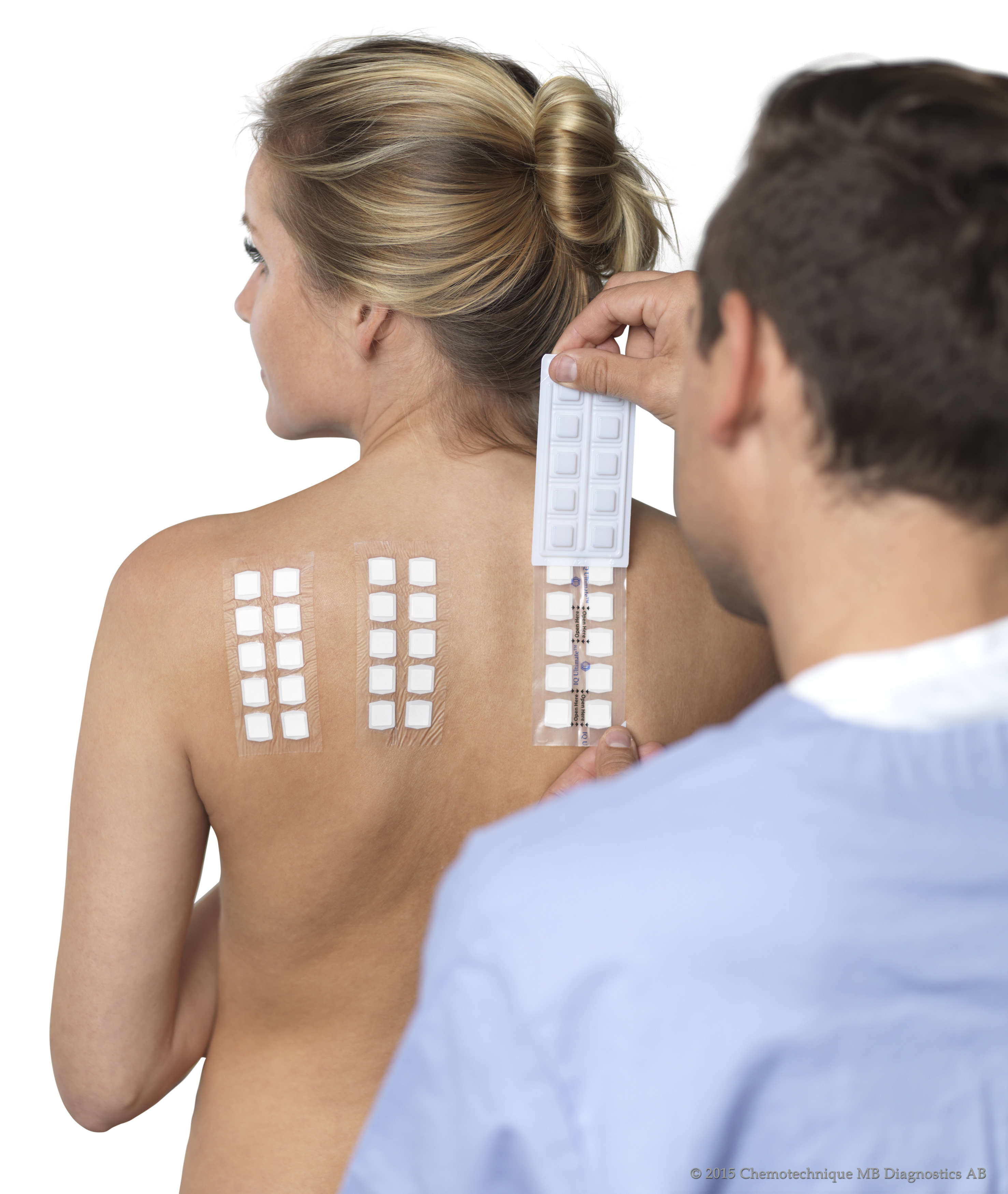
Elastic, transparent and water resistant. In addition to the features shared with the IQ Ultra™ Patch Test Unit, IQ Ultimate™ has the above named added benefits as a result of the 25 micron thin carrier film. IQ Ultimate™ is the ideal Patch Test Unit for children and active patients as it is flexible and allows for showers. IQ Ultimate™ is the perfect choice for tropical climate and testing during hot summers due to its superior adhesion to the skin.
Patch Test Hapten Series
- European Baseline Series
- International Comprehensive Baseline Series
- Bakery Series
- Corticosteroid Series
- Cosmetic Series
- Cutaneous Adverse Drug Reaction Series
- Dental Screening Series
- Dental Materies - Patients Series
- Dental Materials - Staff Series
- Epoxy Series
- European Photopatch Baseline Series
- European Photopatch Extended Series
- Fragrance Series
- Hairdressing Series
- International Standard Series
- Isocyanate Series
- Leg Ulcer Series
- Medicament Series
- Metal Series
- (Meth) Acrylate Series - Adhesives, Dental & Other
- (Meth) Acrylate Series - Nails Artificial Series
- (Meth) Acrylate Series - Printing Series
- Oil & Cooling Fluid Series
- Photographic Chemicals Series
- Shoe Series
- Sunscreen Series
- Textile Colours & Finish Series
- Various Series
Australian Baseline Series 2017
| No. | Hapten name | ||
| 1 | Nickel(II)sulfate hexahydrate | ||
| 2 | Peru balsam | ||
| 3 | COLOPHONIUM | ||
| 4 | DIAZOLIDINYL UREA (Germall II) | ||
| 5 | p-PHENYLENEDIAMINE (PPD) | ||
| 6 | 2-Mercaptobenzothiazole (MBT) | ||
| 7 | FORMALDEHYDE | ||
| 8 | Potassium dichromate | ||
| 9 | LANOLIN ALCOHOL (Wool alcohol) | ||
| 10 | Epoxy resin, Bisphenol A | ||
| 11 | Hydroperoxides of Linalool | ||
| 12 | Neomycin sulfate | ||
| 13 | Cobalt(II)chloride hexahydrate | ||
| 14 | IMIDAZOLIDINYL UREA (Germall 115) | ||
| 15 | Paraben mix | ||
| 16 | Thiuram mix | ||
| 17 | Mercapto mix | ||
| 18 | Fragrance mix I | ||
| 19 | Black rubber mix | ||
| 20 | METHYLISOTHIAZOLINONE+ METHYLCHLOROISOTHIAZOLINONE | ||
| 21 | COCAMIDOPROPYL BETAINE | ||
| 22 | Sesquiterpene lactone mix | ||
| 23 | Fragrance mix II | ||
| 24 | 4-tert-Butylphenolformaldehyde resin (PTBP) | ||
| 25 | Toluenesulfonamide formaldehyde resin | ||
| 26 | QUATERNIUM-15 (Dowicil 200) | ||
| 27 | Tixocortol-21-pivalate | ||
| 28 | Benzocaine | ||
| 29 | Budesonide | ||
| 30 | PROPYLENE GLYCOL |
| No. | Hapten name | ||
| 31 | BENZYL ALCOHOL | ||
| 32 | Tea Tree Oil oxidized | ||
| 33 | CETEARYL ALCOHOL | ||
| 34 | Compositae mix II | ||
| 35 | p-CHLORO-m-CRESOL | ||
| 36 | Basic Red 46 | ||
| 37 | CHLOROACETAMIDE | ||
| 38 | Methylprednisolone aceponate | ||
| 39 | Mixed dialkyl thiourea | ||
| 40 | COCAMIDE DEA | ||
| 41 | DMDM HYDANTOIN | ||
| 42 | Carba mix | ||
| 43 | Hydroperoxides of Limonene | ||
| 44 | BENZOPHENONE-3 | ||
| 45 | BENZOPHENONE-4 | ||
| 46 | BENZALKONIUM CHLORIDE | ||
| 47 | HYDROXYISOHEXYL 3- CYCLOHEXENE CARBOXALDEHYDE (Lyral) | ||
| 48 | Textile dye mix | ||
| 49 | Amerchol L-101 | ||
| 50 | Betamethasone 17,21-dipropionate | ||
| 51 | Bufexamac | ||
| 52 | ETHYLHEXYL METHOXYCINNAMATE (Parsol MCX, Escalol 557) | ||
| 53 | CHLOROXYLENOL (PCMX) | ||
| 54 | 2-BROMO-2-NITROPROPANE-1,3-DIOL (Bronopol) | ||
| 55 | Betamethasone-17-valerate | ||
| 56 | 2-Hydroxyethyl methacrylate | ||
| 57 | Triamcinolone acetonide | ||
| 58 | Lidocaine | ||
| 59 | IODOPROPYNYL BUTYLCARBAMATE | ||
| 60 | METHYLISOTHIAZOLINONE | ||
New Zealand Baseline Series (NZBS)
| No. | Hapten name |
| 1 | Nickel sulfate |
| 2 | Myroxylon pereirae |
| 3 | p-Phenylenediamine |
| 4 | Colophonium |
| 5 | Hydroperoxides of linalool |
| 6 | Neomycin sulfate |
| 7 | Cobalt chloride hexahydrate |
| 8 | Thiuram mix |
| 9 | Formaldehyde |
| 10 | Benzophenone 3 |
| 11 | Potassium dichromate |
| 12 | Tixocortol-21-pivalate |
| 13 | Propolis |
| 14 | Lanolin alcohol |
| 15 | Fragrance mix I |
| 16 | Quaternium 15 |
| 17 | Sesquiterpene lactone mix |
| 18 | Cocamidopropyl betaine |
| 19 | 2-Mercaptobenzothiazole |
| 20 | Methylisothiazolinone/methylchloroisothiazolinone |
| 21 | Fragrance mix II |
| 22 | Budesonide |
| 23 | Carba mix |
| 24 | Paraben mix |
| 25 | Tea tree oil oxidised |
| 26 | Benzalkonium chloride |
| 27 | Epoxy resin, Bisphenol A |
| 28 | Hydroperoxides of limonene |
| 29 | Methylisothiazolinone |
| 30 | Textile dye mix |
| No. | Hapten name |
| 31 | Benzoyl peroxide |
| 32 | Amerchol L 101 |
| 33 | Propylene glycol |
| 34 | Cinnamal |
| 35 | Mercapto mix |
| 36 | Hydroxyisohexyl 3-cyclohexene carboxaldehyde |
| 37 | Compositae mix II |
| 38 | 4-tert butylphenol formaldehyde resin (PTBP) |
| 39 | 2-Bromo-2-nitropropane-1,3-diol (bronopol) |
| 40 | Disperse blue mix 106/124 |
| 41 | Diazolidinyl urea |
| 42 | Caine mix III |
| 43 | Hydrocortisone-17-butyrate |
| 44 | Imidazolidinyl urea |
| 45 | Cetearyl alcohol |
| 46 | Toluenesulfonamide formaldehyde resin |
| 47 | 2-Hydroxyethyl methacrylate |
| 48 | Benzyl alcohol |
| 49 | Clobetasol-17-proprionate |
| 50 | Cinnamyl alcohol |
| 51 | DMDM hydantoin |
| 52 | Cocamide DEA |
| 53 | Benzophenone 4 |
| 54 | Isoeugenol |
| 55 | Chloroxylenol |
| 56 | Oakmoss absolute |
| 57 | N-Isopropyl-N-phenyl-4-phenylenediamine |
| 58 | Iodopropynyl butyl carbamate |
| 59 | Black rubber mix |
| 60 | Ethylhexyl methoxycinnamate |
More on the Australian Baseline Series
- Nickel(II)sulfate hexahydrate
Nickel metal is a common hapten present in various alloys, electroplated metal, earrings, watches, buttons, zippers, rings, utensils, tools, instruments, batteries, machinery parts, working solutions of metal cutting fluids, nickel plating for alloys, coins, pigments, dentures, orthopaedic plates, keys, scissors, razors, spectacle frames, kitchenware etc.
- Peru balsam
Found as flavour in tobacco, drinks, pastries, cakes, wines, liquors, spices etc. Used as a fixative and fragrance in perfumery. Also used in topical medicaments, dentistry, etc. Consists of esters of cinnamic, benzoic acid, vanillin and styracine. Also known as Balsam Peru, Myroxylon pereirae resin, Indian balsam, China oil, Black balsam, Honduras balsam and Surinam balsam.
- COLOPHONIUM
A yellow resin used in the production of varnishes, printing inks, paper, soldering fluxes, cutting fluids, glue tackifiers, adhesives, surface coatings, polish, waxes, cosmetics (mascara, rouge, eye shadow), topical medicaments, violin bow rosin, athletic grip aid, pine oil cleansers. Component in dental impression materials and periodontal packings. Also known as Colophony.
- DIAZOLIDINYL UREA (Germall II)
A preservative used in cosmetic creams, lotions, shampoos, hair gels, etc. (Germall II). Also known as 2,5-Diazolidinylurea.
- p-PHENYLENEDIAMINE (PPD)
The primary intermediate in permanent hair dyes and fur dyes (valid for p-PHENYLENEDIAMINE (PPD)). Also used in photographic developers, lithography, photocopying, oils, greases, gasoline and as antioxidant/accelerator in the rubber and plastic industry. The hydrochloride is used as blood reagent.
- 2-Mercaptobenzothiazole (MBT)
An accelerator, retarder, and peptizer for natural and other rubber products such as shoes, gloves, rubber in undergarments and clothing, condoms and diaphragms, medical devices, toys, tires and tubes, renal dialysis equipment, swimwear. Can also be used as a fungicide and works as a corrosion inhibitor in soluble cutting oils and antifreeze mixtures. Also used in greases, adhesives, photographic film emulsions, detergents, veterinary products such as tick and flea powders and sprays.
- FORMALDEHYDE
Used in the production of urea, phenolic melamine and acetal resins. Found in textile products. Used as astringent, disinfectant, preservative in cosmetics, metalworking fluids, shampoos, etc. Other exposure areas include antiperspirant in cosmetics, anticracking agent in dental plastics, anhidrotics, chipboard production, cleaning products, disinfectants and deodorizers, dry-cleaning materials, glues, mineral wool production, paints and coatings, paper industry, phenolic resins and urea plastics in adhesives and footwear, photographic paper and solutions, polishes, printing materials, tanning agents, wart remedies, embalming solutions, fertilizers, wood composites, insulation.
- Potassium dichromate
The hexavalent form of chromium, which is used in cement, tanning of leather, textile dyes, wood preservatives, alloys in metallurgy, safety matches, photography, electroplating, anticorrosives, engraving and lithography, ceramics, automobile industry, TV manufacturing, photocopy paper, tattoos, mascara/eye shadow pigments (chromium oxide), milk testing, welding, floor waxes, shoe polishes, paints, glues, pigments, detergents, etc.
- LANOLIN ALCOHOL (Wool alcohol)
Different types of alcohols (aliphatic, steroid, triterpenoid) present in wool fat (lanolin). Used as ointment base in cosmetic and pharmaceutical products. Also known as Wool alcohols.
- Epoxy resin, Bisphenol A
A resin based on diglycidyl ester of hexahydrophthalic acid. Its main use is for the manufacture of electrical insulating components (bushings, apparatus parts, insulators).
- Hydroperoxides of Linalool
Linalool is found in fine fragrances, cosmetics, and hygiene products as well as in household and industrial products. Linalool is among the most commonly found fragrance ingredients in consumer products presently available. Linalool is a naturally occurring terpene, present in large amounts in various plants, for example in lavender, rosewood, bergamot and jasmine. Linalool autoxidize on air exposure at room temperature forming hydroperoxides. Compared to pure unoxidized linalool the hydroperoxides of oxidized linalool have shown to be far more allergenic.
- Neomycin sulfate
A broad-spectrum antibiotic found in topical creams, powders, ointments, eye and ear drops. Also used as systemic antibiotic and growth promotor in veterinary use.
- Cobalt(II)chloride hexahydrate
A component used in colouring of glass and porcelain. Works as a siccative in paints. Used in various alloys (dental, etc.)
- IMIDAZOLIDINYL UREA (Germall 115)
A preservative used in lotions, creams, hair conditioners, shampoos, deodorants and topical drugs. Works as a formaldehyde releaser.
- Paraben mix
Consists of BUTYLPARABEN, ETHYLPARABEN, METHYLPARABEN, PROPYLPARABEN
- Thiuram mix
Consists of dipentamethylenethiuram disulphide, tetraethylthiuram disulphide, tetramethylthiuram disulfide (TMTD) and tetramethylthiuram monosulfide (TMTM).
- Mercapto mix
Consists of N-Cyclohexyl-2-benzothiazolesulfenamide, 2-Mercaptobenzothiazole (MBT), Dibenzothiazyl disulfide (MBTS) and 2-(4-Morpholinylmercapto)benzothiazole (MOR).
- Fragrance mix I
Consists of AMYL CINNAMAL, CINNAMYL ALCOHOL, CINNAMAL, EUGENOL, GERANIOL, HYDROXYCITRONELLAL, ISOEUGENOL and Oakmoss absolute.
- Black rubber mix
Consists of -N-Cyclohexyl-N-phenyl-4-phenylenediamine, N,N´-Diphenyl-p-phenylenediamine and N-Isopropyl-N-phenyl-4-phenylenediamine (IPPD).
- METHYLISOTHIAZOLINONE+ METHYLCHLOROISOTHIAZOLINONE
This product, a component in biocides, is used as a preservative in oil and cooling fluids, soaps, latex emulsions, slime control in paper mills, jet fuels, milk sampling, radiography, printing inks, moist toilet paper, detergents, shampoos, hair conditioners, hair & body gels, bubble baths, skin creams and lotions, mascaras, etc.
- COCAMIDOPROPYL BETAINE
A surfactant found in liquid soaps, shampoos, hair colorants, shower and bath formulations. Also known as Tegobetaine.
- Sesquiterpene lactone mix
Consists of alantolactone, costunolide and dehydrocostus lactone.
- Fragrance mix II
Consists of hexyl cinnamic aldehyde, COUMARIN, FARNESOL, HYDROXYISOHEXYL, 3-CYCLOHEXENE, CARBOXALDEHYDE, CITRAL and CITRONELLOL.
- 4-tert-Butylphenolformaldehyde resin (PTBP)
Resin used in adhesives for shoes and watch straps. Also found in do-it-yourself glues, plywood, insulation, automobiles, motor oils, inks, papers, film developers, disinfectants, deodorants.
- Toluenesulfonamide formaldehyde resin
A modifier and adhesion promotor used for film forming natural and synthetic resins. Occurs in vinyl lacquers, nitrocellulose compositions (e.g. nail lacquers), PVA adhesives, acrylics.
- QUATERNIUM-15 (Dowicil 200)
A formaldehyde-releasing preservative in hand creams, lotions, face creams, shampoos, latex paints, topical medicaments, polishes, metal working fluids, adhesives, inks, etc.
- Tixocortol-21-pivalate
A topical corticosteroid belonging to the group A (hydrocortisone) type of steroids used in nasal sprays for the treatment of rhinitis. Good marker for group A corticosteroid contact allergy.
- Benzocaine
Local and topical anaesthetic used in products such as burn and sunburn remedies, hemorrhoidal creams, suppositories, creams for treatment of poison ivy, oral and gingival products, sore throat sprays/lozenges, astringents, appetite suppressants.
- Budesonide
A nonhalogenated corticosteroid for use in topical preparations and for the treatment of rhinitis and asthma. Belongs to the group B (triamcinolone acetonide) type of corticosteroids. Good marker of corticosteroid allergy.
- PROPYLENE GLYCOL
Used as vehicle in pharmaceutical and cosmetic bases. In food it is used as solvent for colours and flavours and to prevent growth of moulds. Works as humectant and can also be found in cooling fluids.
- BENZYL ALCOHOL
Solvent in photography, perfumery and for dyestuffs, inks, pharmaceutical products, etc. Used as preservative in injectable drugs, ophthalmic solutions, and oral liquids.
- Tea Tree Oil oxidized
Oil from distilled leaves of Melaleuca Alternifolia. Pale yellowish green oil of a warm spicy aromatic terpenic odor. The oil has served as an antiseptic for many decades but is now also sold as a remedy for various skin and nail conditions. Also present in household products like cleansers, laundry agents and fabric softeners.
- CETEARYL ALCOHOL
A combination of cetyl (C16) and stearyl (C18) alcohols 50/50 used as emulsifier and emollient in cosmetic lotions, creams, ointments and pharmaceutical preparations.
- Compositae mix II
Anthemis nobilis extract, Chamomilla recutita extract, Achillea millefolium extract, Tanacetum vulgare extract, Arnica montana extract and Parthenolide.
- p-CHLORO-m-CRESOL
A fungicide found in creams, topical antiseptics, pharmaceutical products, protein shampoos, baby cosmetics, and cooling fluids.
- Basic Red 46
Monoazo dye used for acrylic and polyester textiles (sweaters, etc.).
- CHLOROACETAMIDE
A preservative in cosmetic and pharmaceutical creams, shampoos, bath lotions, etc. Also as preservative in glues and cooling fluids.
- Methylprednisolone aceponate
A topical corticosteroid used for treating eczema and psoriasis, it suppresses inflammatory and allergic skin reactions and thus relaxes symptoms originating from the skin problem like redness (erythema), thickening of the skin, coarseness of the skin surface, fluid build-up (oedema), itchiness, and other complaints (burning sensation or pain. Due to its high lipophilicity and the fact that it is bioactivated in the skin, enables single daily application without any loss of efficacy. Also known as Advantan.
- Mixed dialkyl thiourea
Consists of N,N´-Dibutylthiourea and N,N´-Diethylthiourea, an accelerator for mercaptan-modified chloroprene rubber. Used as an activator for ethylene-propylene-diene terpolymers and natural rubber, as well as an antidegradant for natural rubber-latex and thermoplastic styrene-butadiene rubber.
- COCAMIDE DEA
Mixture of ethanolamides of coconut acid. Found in bath, shower and body cosmetics and in cooling fluids.
- DMDM HYDANTOIN
Functions as a formaldehyde donor and is used as a preservative in cosmetic products and is active against fungi, yeasts, and bacteria. Products preserved are of the type shampoos, skin-care products, hair conditioners, makeup, hair rinses, and cleanliness products. Also used in herbicides, polymers, colour photography, latex paints, floor waxes, cutting oils, adhesives, copying paper, inks.
- Carba mix
1,3-Diphenylguanidine, ZINC DIBUTYLDITHIOCARBAMATE (ZBC) and Zinc diethyldithiocarbamate (ZDC).
- Hydroperoxides of Limonene
Limonene is found in cosmetics, fine fragrances and hygiene products as well as in household and industrial products. Limonene is one of the most commonly found fragrance ingredients in consumer products presently available. Limonene is a naturally occurring terpene, present in large amounts in various citrus fruits. Limonene autoxidize on air exposure at room temperature forming hydroperoxides. Compared to pure unoxidized limonene the hydroperoxides of oxidized limonene have shown to be far more allergenic.
- BENZOPHENONE-3
Common UV-adsorber in dental composite materials and other plastic materials. Used as a UV-adsorber in topical sunscreens, moisturizers, shampoos, hair care products, lipsticks, lip balms, nail polish, etc.
- BENZOPHENONE-4
Sunscreen for use in various sunscreen products as well as in textiles, plastics, paints and cosmetics.
- BENZALKONIUM CHLORIDE
Topical quaternary ammonium antiseptic agent found in ophthalmic (eye) preparations, skin disinfectants, cosmetics, deodorants, mouthwashes, dentifrices, sterilization solutions, lozenges, and solutions for contact lenses.
- HYDROXYISOHEXYL 3- CYCLOHEXENE CARBOXALDEHYDE (Lyral)
A fragrance known for its soft delicate floral, lily, cyclamen note reminiscent of hydroxycitronellal. Used in products such as Alcoholic Lotion, Anti-Perspirant, Deo Stick, Detergent Perborate, Detergent TAED, Fabric Softener, Hard Surface Cleaner, Shampoo and soap.
- Textile dye mix
Consists of Disperse Blue 35, Disperse Orange 1, Disperse Orange 3, Disperse Red 1, Disperse Red 17, Disperse Yellow 3, Disperse Blue 106 and Disperse Blue 124.
- Amerchol L-101
Trade name of product containing lanolin alcohols obtained from hydrolysis of lanolin. Emulsifier and emollient in cosmetic and pharmaceutical bases, topical drugs, furniture polish, leather, metal corrosion prevention, paper, inks, textiles, furs, cutting oils, waxes.
- Betamethasone 17,21-dipropionate
Betamethasone dipropionate is a glucocorticoid steroid with anti-inflammatory and immunosuppressive abilities. It is applied as a topical cream, ointment, lotion, aerosol sprays or gel to treat itching and other minor skin conditions such as eczema.
- Bufexamac
Drug used as an anti-inflammatory agent on the skin, as well as rectally. Ointments and lotions containing bufexamac are used for the treatment of subacute and chronic eczema of the skin, including atopic eczema, as well as sunburn and other minor burns, and itching. Suppositories containing bufexamac in combination with local anaesthetics are used against haemorrhoids.
- METHYLHEXYL METHOXYCINNAMATE (Parsol MCX, Escalol 557)
An UV-B absorbing agent in sunscreens and cosmetic creams, lotions, lipsticks, sun oils, etc.
- CHLOROXYLENOL (PCMX)
A preservative found in cooling fluids, creams, topical and urinary antiseptics. Can also be found in pharmaceutical products, hair conditioners, toilet and deodorants, soaps, electrocardiogram paste, etc.
- 2-BROMO-2-NITROPROPANE-1,3-DIOL (Bronopol)
Used a preservative in cooling fluids, hand & face creams, shampoos, hair dressings, mascaras, cleansing lotions, milk sampling, paints, textiles, humidifiers, pharmaceutical products, washing detergents
- Betamethasone-17-valerate
Topical and systemic corticosteroid of group C type with a C-16 methyl substitution.
- 2-Hydroxyethyl methacrylate
A methacrylic monomer used in UV-inks, adhesives, lacquers, dental materials, artificial nails etc.
- Triamcinolone acetonide
A topical and systemic corticosteroid belonging to the group B (triamcinolone acetonide) type of steroids.
- Lidocaine
Used as a local anaesthetic and as antiarrhythmic agent.
- IODOPROPYNYL BUTYLCARBAMATE
A compound used as fungicide and bactericide for wood and paint preservation and in cooling fluids. Now also permitted and used as a cosmetics preservative in products such as shampoos, lotions, creams, powders and baby products.
- METHYLISOTHIAZOLINONE
A component in Kathon CG which is used as preservative for use in cosmetics, shampoos, cooling fluids, detergents etc.

